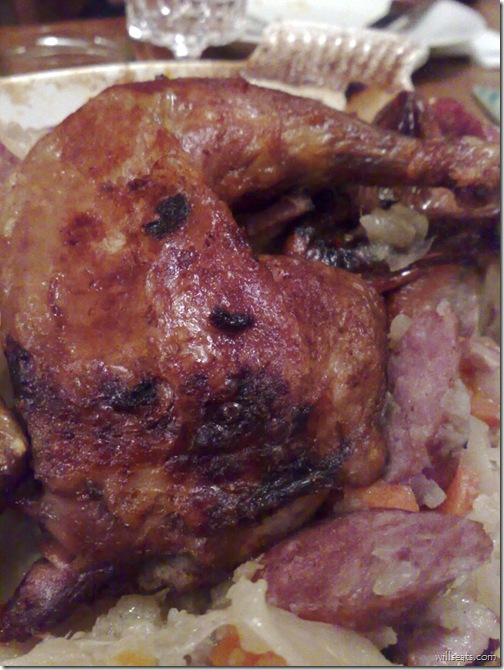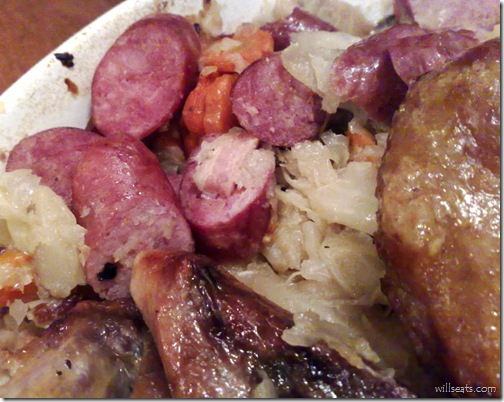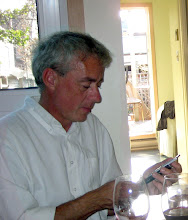Guinea Hen with Cabbage : Pintadeaux au Chou : Lesson 7 : Part 2 : LCB at Home
These will be posted non-sequentially; with part 1 coming later, since the pictures of the guinea hen is more to the point of the lesson today; that being - - learn from your mistakes.
This was a tough one. Of the three parts; starter, main & dessert, each of them had some sort of glitch. Starting with the guinea hen pricing out initially at 9 bucks a pound (20 bucks a kilo! for a bird!). Lucked out and found them eventually at 5 a pound which was much less painful and acquired therefore the proper fowl for the dish (otherwise we'd have been eating chicken [or maybe Cornish hens]).
That's quartered Guinea Hen on a bed of cabbage with Polish Sausage, bacon (lardons) and carrots. I didn't take a shot of the whole plate because, although piled high, it was not especially attractive.
The cabbage got kudos as did some parts of the fowl.
What went right &/or wrong:
- the hen was initially undercooked (after the planned amount of time it checked out as "done" when poked but the interior joints were not finished cooking `[sort of raw looking] - I'll explain why in the notes)
- then overcooked (in trying to recover [cook] after quartering the guinea hen I stuffed the meat pieces back in for 10 more minutes; they cooked but the legs dried out - - See the notes for thoughts on that)
- and the cabbage was overdone in that it was extremely soft and disintegrating. Would have preferred leaves with somewhat more integrity. (But just the cabbage part of the recipe, without any bird, is doable as a standalone dish)
- If getting two birds get them in equal sizes so they'll cook more or less the same - one was done much more than the other
This lesson needs to be repeated to get it right - - some day. From Lesson 7 in the book Le Cordon Bleu: At Home.
Pintadeaux au Chou : Guinea Hen with Cabbage
Serves: 6
Ingredients
- 1 cabbage
- 1 onion
- butter
- oil
- 350 g carrots [3/4 #]
- bouquet garnis
- 500 ml water [2 C]
- 350 g back bacon, cubed [3/4 #]
- 2 Guinea Hens
- salt
- pepper
- bay leaf
- thyme sprig
- butter
- more salt
- more pepper
- 350 g Polish Sausage, whole (at first) [3/4 #]
Procedure
- Blanch the cabbage leaves for 10 minutes then rinse with cold water
- Sauté the onions, in 50-50 oil and butter, until soft but not browned (as usual)
- add the carrots for a minute
- add the bouquet garnis, the cabbage and the half liter of water
- bring to a boil then simmer for 45 minutes (don't let it go dry)
- Meanwhile, blanch the bacon (5 minutes) and rinse the bits
- then fry up the bacon bits until toasty, drain; add to cabbage when the cabbage is done
- But... while the cabbage is cooking ... oven to 200 C [425F] & roast the trussed guinea hens (salt, pepper, bay leaf thyme inside - - butter smeared, salt and pepper outside)
- for 30 minutes, turning twice (for color)
- De-glaze the roasting pan with half a cup of water and strain the result into the cabbage
- Then prick the sausage, put in the bottom of the pan, cover with cabbage, place the hens on top, cover the whole thing (see notes) and do another 30 minutes
- Check for doneness; when so... quarter the hens, slice the sausage and serve
Notes
- Off the top, the problem with the guinea hen... it was supposed to be cook in a covered casserole dish at 425 F for 30 minutes but there was not a covered ovenproof dish of great enough size. They were, instead done with a foil tent over them (to prevent burning the skin).
That was the problem with the unpredictable doneness of the birds (thigh and breast was done but deep in the joint it was near raw); the high temp is meant to create a hot, steamy atmosphere inside a closed dish. I had not a closed but an open dish therefore nothing hot and steamy was going on. I was getting straight, out and out, baking.
It would have been better to back off to 180C [375F] and cook for 45 minutes or so. That is... slower, lower and longer. - The attempted recovery of the undercooked joints was to put the undercooked parts of the meat (only) back in; but I messed up that too and put it back in with the oven still at 220C [475] and it did cook the meat but it also dried out the skinny part of the drumsticks. Better would have been to bake at a lower temp and to cover the "done" part of the drumsticks with foil.
- Blanching the cabbage gets rid of some classic bitterness and/or gassiness,
- Blanching the bacon removes any powerful "smoky" taste and a lot of fat
- Roasting the hens, initially, in a pan just barely big enough is best (prevents scorching of the fats, the drippings, in the bottom)
- Do not baste the birds with their juices (it ruins the crispy skin)
- Quartering: cut/chop in half vertically along the spine and breast; then remove each drumstick/thigh portion. You can also, as I did, remove the more or less meatless ribcage part (save all remnants for making stock later).




No comments:
Post a Comment